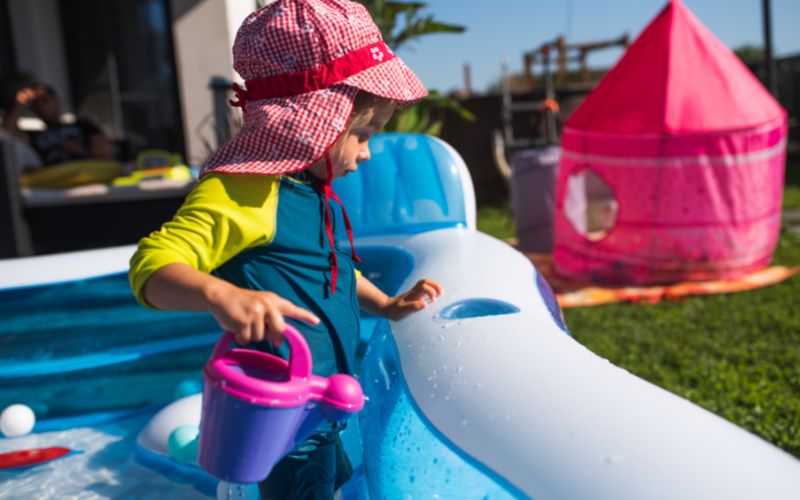When you own an inflatable pool, you want to protect it as best as possible so that you can ideally get many years of use from it. But unfortunately, inflatable pools can sometimes get a puncture or a tear.
With cheap smaller pools, it might not be worth the effort to repair it, but if you’ve paid for a good one, or you’re particularly keen on protecting the environment and avoiding unnecessary plastic waste, then you can try to patch a hole.

Most inflatable pools will come with a repair kit, although it’s often pretty basic – usually consisting of a single adhesive patch that won’t last long at all.
Instead, let’s take a look at how to fix a hole in an inflatable pool the proper way so that you can still enjoy using it for a while.
How do you fix a leak in an inflatable pool?
To fix a leak in an inflatable pool, you first need to locate it. Clean and dry the area around the leak, and then apply a patch while the pool is inflated, using suitable watertight adhesive. Patches should be circular to prevent corners from fraying.
It’s worth noting at this stage that it can be difficult to patch a hole bigger than a typical nickel size. If you want to know how to fix a ripped inflatable pool that has a large tear in it, the sad answer is that you might not be able to.
Feel free to try, using the steps below, but the integrity of the repair might not hold up, and you may just need to replace the pool.
How to find a hole in an inflatable swimming pool
You can’t fix what you can’t see. Therefore, to patch a leaking inflatable pool, you have to know exactly where the leak is.
If the leak is a water leak, this is normally pretty easy to find. But if you’re struggling, because the leak is on the bottom and the pool is too heavy to lift up, try this: place the empty pool onto a dry hard surface, and fill it with less than an inch of water.
Leave it for around a minute, and then lift the pool away. You’ll see a wet patch on the floor, which will help you to identify where on the pool the leak is coming from.
For air leaks, there’s a handy trick to finding a leak that’s invisible to the naked eye. Inflate the pool to the maximum and you can use the soapy water technique to locate the puncture.
The soapy water technique involves spraying water mixed with dish soap over the area of concern, or the whole pool if you have no idea where the hole might be. The punctured area will push air through the mixture, creating bubbles. To be absolutely sure, wipe and spray the area again for confirmation.
Check out this video to see the technique in action:
Once you have identified where the leak is coming from, mark it so that you know exactly where to place the patch. You can use a marker pen, but if you use a dry wipe then it could get accidentally wiped away. A piece of low-adhesive tape is a better option.
Failing to mark the leak may lead to you patching the wrong part of the pool, or losing the spot and having to repeat the first step all over again.
The best way to patch an inflatable pool
The best way to patch an inflatable pool is to use a proper inflatable repair kit. Patches should be around 2 inches wider than the leak and should be circular, otherwise, corners could peel away.
You can use any plastic or rubber for a makeshift patch if you’re in urgent need of a pool repair, but proper repair kits use materials that are designed to expand and contract as your inflatables are, well, inflated (and deflated).
You want to cut the patch to be around 2 inches around the hole so that there’s ample space around it to properly seal the leak. Avoid using square or rectangle patches as the corners can fray and peel away from the pool, exposing the hole again.
You’ll want the pool to be fully inflated (or as inflated as possible) when you apply the patch. This will make it easier to stick it in place. But before you worry about that, you need to empty it of all water.
Then, clean the site of the puncture, and make sure it’s fully dry. If there’s any moisture then you’re going to compromise the adhesion of the patch, so don’t cut corners with this step.
Read more: How To Dry An Inflatable Pool
Finally, rub low-grade sandpaper around the site of the hole. Just gently – you don’t want to make the hole bigger. All you’re doing here is very slightly roughing up the pool so that there’s more surface area for the glue to stick to.
How do you seal a hole in an inflatable pool?
To seal a hole in an inflatable pool, you need to use a watertight glue or adhesive. This will seal the patch to the pool wall, making sure no water or air can escape. You can add extra adhesive over the patch to create a full seal if you wish.
Add a small dab of adhesive onto the site of the hole, with the pool inflated. The glue should cover the hole and be enough to spread to the full patch, without being excessive. It’s not the end of the world if you use too much, but make sure there’s enough that the entire patch will hold in place.
Lastly, stick the patch over the hole, and then press it into place, ensuring all the edges are flat against the inflated pool surface. Keep the pool inflated throughout, as this will help you make sure that no air is escaping.
Remember to hold off filling the pool with water until the glue is completely dry and the patch holds properly. It’s best to wait a full day if you can.
What causes leaks in inflatable pools?
Inflatable swimming pools are not built to last a lifetime. If they were, they would be a lot more expensive and harder to assemble.
Instead, they’re made from a cheaper plastic that will weather and age under UV light. Sunlight will eventually weaken the structure of the pool, making the occasional puncture inevitable.
Another common cause of leaks in inflatable pools is quite obvious – sharp things. These include sharp toys, stones that have been missed underneath the pool, and pets that have claws and sharp teeth. If your dog likes to splash around, they could accidentally puncture your pool quite easily.

Be careful doing any garden work near your pool as well. Even things like mowing a lawn can kick up small stones that could impact your pool and cause a minor tear. If you can, move your pool out of the way while you’re doing any garden work.
Lastly, handling the pool carelessly when storing it could lead to holes and tears. Make sure you look after it as best as you can when you’re deflating it, folding it, and storing it away. If you’re storing it in a garage or similar outdoor building, make sure it’s high enough that any small rodents can’t bite it.
Read more: How to Store an Inflatable Pool
Final Words
If you have an inflatable pool, knowing how to patch it up when it has a leak should be a basic skill. Leaks are inevitable, but you don’t want to throw away your pool every time a small hole appears.
As long as you have a good quality repair kit, the actual process of fixing a hole is easy enough. Just take your time and follow the steps carefully, otherwise, you may not properly seal it and you could end up with an unrepairable leak.


